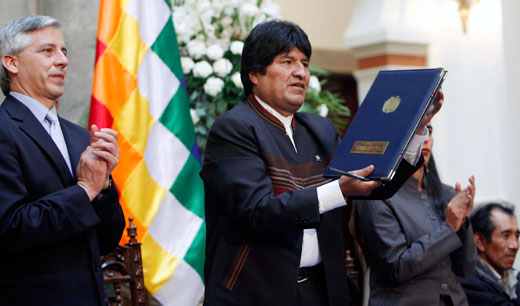
Bolivia’s socialist government plans to route a 190-mile north-south highway through the “Isidoro Sécure National Park and Indigenous Territory (TIPNIS). Many of the 12,500 residents of the 2.5 million acre preserve in Cochabamba are up in arms over a highway envisioned by earlier governments. A Brazilian construction firm has been engaged, and Brazil will provide partial funding. Both countries have long sought improved overland connections ultimately leading to Pacific ports.
An indigenous-led government at odds with an indigenous opposition exemplifies one contradiction surfacing during the fight. Another comes from economic imperatives seen as undermining ideals of indigenous autonomy and environmental integrity. And the controversy has inflamed old divisions within indigenous ranks. .
Representatives of 37 pro-government groups organized by the Indigenous Council of the South (CONISUR) arrived in La Paz on January 30 after marching 300 miles from the TIPNIS preserve. Negotiations with parliamentary leaders led to agreement that a constitutionally sanctioned law would be passed authorizing the government to secure highway approval through consultations with all 63 TIPNIS indigenous communities.
The Confederation of Indigenous Peoples of Bolivia (CIDOB) demurred. Spokespersons cited the law Parliament passed three months earlier nixing the project, at least temporarily, and putting a hold on highway construction. They warned they might soon be marching, again.
CIDOB had brought thousands of anti-government, indigenous marchers from the TIPNIS to La Paz in October 2011. There had been police attacks and arrests on the way. CIDOB leaders forced a remorseful government to capitulate.
Critics of the proposed highway point to a contradiction: plans afoot now for Brazil’s state-owned petroleum giant Petrobas to use the highway for removing oil and gas follow government celebration of independence from foreign trans-national corporations in 2006 following nationalization of hydrocarbon production.
The government proposal has inflamed animosities between indigenous peoples living in the Amazonian TIPNIS region and Bolivia’s indigenous majority situated in the highlands. Tens of thousands of the latter, coca-growing migrants to the TIPNIS embrace the highway idea. And foreign and domestic environmentalist organizations lambast it. The environment will suffer, they say, from oil and gas extraction and deforestation at the hands of coca growers and lumber companies.
Paradoxically, separatist, rightwing landowners in Beni to the north of TIPNIS and in Santa Cruz to the south and east take the government’s side in the highway fight. They favor a highway promising to reduce mileage required for transport of agricultural products.
Throughout, defenders of the government have argued the highway will promote access to schools, health care services, and jobs for isolated communities. The opposition has resolutely linked defense of TIPNIS integrity with indigenous sovereignty. Former TIPNIS official Adolfo Moye Rosendy, interviewed on the Fobemade website, cited documents showing “clearly that indigenous territory is indivisible, inalienable, and exempt from prescription and that three [indigenous] peoples… are declared as absolute and legitimate owners.”
Yet Fobemade, self-described as the “Bolivian Forum on Development and the Environment,” emerged from a 2011 Parliamentary investigation as a lead offender among NGOs behind indigenous groups protesting the highway. Interviewed recently by Mexico’s La Jornada news service, Vice President Álvaro García Linera claimed the United States Agency for International Development (USAID) has financed a multitude of anti-Morales NGOs. In 2010, President Morales himself included Fobomade in that category. The next year, his government expelled USAID’s Environment and Economic Development program from Bolivia.
Analyst Jose Steinsleger explained recently that, according to declassified U.S. intelligence documents, “USAID foments conflicts between partisans of development and resource extraction and defenders of the environment.”
He thus describes U. S. maneuvers building on underlying divisions. The Bolivian Communist Party suggested in September 2011 that highway opponents seek “to disparage the government through situations of tension and divisions within the social base of original, indigenous peoples and small farmers, with confrontations among different people’s organizations.”
The highway controversy serves as backdrop for Garcia Linera’s notion that “foreign hands” are removed from control of natural resources. Now, he said, “The state is the principal generator of wealth in the country and that wealth is valued not as capital, but is redistributed in society through vouchers, income, and direct social benefits for the population.” But “to allow Petrobas to promote a lucrative policy of fuel extraction” worries a correspondent for El Dia of Santa Cruz, who adds that Petrobas has moved from 22 percent control of Bolivia’s hydrocarbon production in 2002 to 63 percent in 2009.
The change-oriented Bolivian government, of course, is not alone among Latin American counterparts intent upon securing monetary and infrastructure resources essential for satisfying people’s need for basic survival.
Photo: Bolivia’s President Evo Morales, center, accompanied by Vice President Alvaro Garcia Linera, left, holds up a signed bill calling for a consultation on building a highway through the Isiboro-Secure Indigenous Territory National Park, TIPNIS at the presidential palace in La Paz, Feb. 10. Juan Karita/AP










